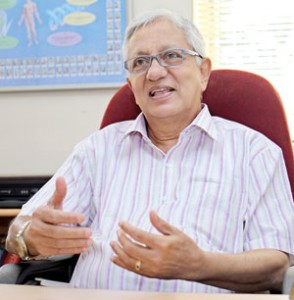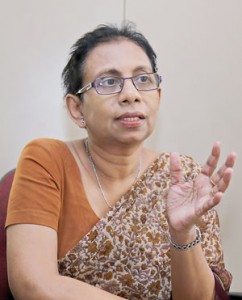News
Many firsts in research flow forth from the IBMBB

A researcher at work at the IBMBB and (inset) the L-shaped building from which emanates groundbreaking research . Pix by Anuradha Bandara
Nestling among the respected and staid halls of learning sprawling across the campus that is the University of Colombo, there is an L-shaped four-storey building adjacent to the College House in Colombo 3.
It may very well be the ‘youngest’ among the other ‘giants’ occupying the area, but from its portals have flowed forth groundbreaking research of relevance to the country and the people……..and it is in recognition of this silent service that Emeritus Prof. Eric H. Karunanayake stood on the podium of The World Academy of Science (TWAS) to accept a prestigious award recently.
Amidst the applause, the TWAS was honouring Prof. Karunanayake for ‘Building Scientific Institutions’ in the Southeast Asia Region, at a ceremony held at its regional centre in Bangalore, India, during its international conference hosted by the Indian Institute of Science and Technology. Wide and varied had been the 20 nominations for this award from Afghanistan, Pakistan, Bhutan, Nepal, India, Bangladesh and Thailand, but Sri Lanka had stood out.
The ‘scientific institution’ built up from scratch by Prof. Karunanayake is the Institute of Biochemistry, Molecular Biology and Biotechnology (IBMBB), a post-graduate training institute of the Colombo University.
Who is the scientist and researcher behind the façade of the IBMBB?
The role of kothala himbutu (Salacia reticulata), beli (Aegle marmelos) and karawila or bitter gourd (Momordica charantia) in fighting diabetes is common knowledge across Sri Lanka. But back in 1981, taking into account that ayurvedic medicine uses many plant-based therapeutic agents and that there had been no scientific evaluation of these therapeutic claims, it was Prof. Karunanayake long before the birth of IBMBB, who ventured into these uncharted territories, coming up with significant findings.
He confirmed that kothala himbutu, beli and karawila all had hypoglycaemic activity. This is while his student, Dr. J. Welihinda, had determined that the aqueous extract of karawila improved the glucose tolerance of newly-diagnosed Type 2 diabetic patients. A subsequent joint study by teacher and student (Prof. Karunanayake and Dr. Welihinda) had shown that karawila extract enhanced the glucose uptake by peripheral tissues, casting light on the possible mechanism of oral hypoglycaemic activity.

Prof. Eric H. Karunanayake
The span of Prof. Karunanayake’s research, conducted alone and sometimes with others, did not end there but also covered the possible toxic effects of anti-diabetic medicinal plants such as karawila (with findings that there was no liver or renal toxicity); the karawila juice while inhibiting intestinal absorption of dietary glucose facilitates glucose storage in the muscle and adipose tissues; the effects of dietary habits on the pharmaco-kinetics of anti-epileptic drugs and much more. He had also been instrumental in establishing the measurement of glycosylated haemoglobin in the management of diabetes in Sri Lanka at that time, used elsewhere but not here.
Around the same time, Prof. Karunanayake’s name is inextricably linked with important research undertaken to develop diagnostic DNA probes for filarial parasites, receiving commendations internationally.
Humble were the beginnings of the IBMBB, meanwhile, with the seeds of its inception being sown way back in 1979-80 by Prof. K. Balasubramaniam of the Department of Biochemistry, Faculty of Medicine, Colombo University. On sabbatical at the Biomedical Centre of the Uppsala University in Sweden, sponsored by the International Programme in Chemical Sciences (IPICS), he had mooted the idea of the potential of developing countries in venturing into the field of molecular biology and biotechnology. Considered “too sophisticated and expensive”, his vision of setting up a laboratory and training staff back home had been met with understandable hesitation.
Not a man to take no for an answer, Prof. Balasubramaniam had persisted, introducing molecular biology and biotechnology at the University of Colombo, with support from IPICS. The tragic events in Sri Lanka in 1983 had led to these plans being placed on the backburner, while Prof. Balasubramaniam had taken up a posting at the University of Jaffna.
The University of Colombo and IPICS had, however, not given up on this idea and a search had been launched for the ‘right’ scientist to take over from where Prof. Balasubramaniam had left off. This was to flesh out the idea of such a laboratory and set it up. It was then that the spotlight had fallen on Prof. Karunanayake who had a “solid” grounding in biochemistry topped by several years of successful research.
Many discussions later with several Swedish academics, with the focal point being the then Chairman of the Department of Medical Genetics, Prof. Ulf Pettersson, the idea had blossomed into the IBMBB by 2004.
Earlier, in 1985, Prof. Karunanayake and Dr. Welihinda had trained for a year in Prof. Pettersson’s laboratory at the Uppsala University. Realizing the vital importance of funding for any Sri Lankan research institution to take off, Prof. Karunanayake had tapped the Swedish Agency for Research Cooperation (SAREC) with Developing Countries with the ready support of the then Vice Chancellor of the Colombo University, Prof. Stanley Wijesundera.
Meticulous plans, while in Sweden, for a molecular biology laboratory had been turned into reality by the end of 1986, with the two strong objectives of: Undertaking post-graduate training at the levels of Master of Science (MSc) and Doctor of Philosophy (PhD) and initiation of a research programme relevant to Sri Lanka using the tools of molecular biology and gene technology.

Prof. Kamani H. Tennekoon
Buffeted by financial winds, it had been the support of SAREC’s Dr. Carl Gustaf Thornstrom which had helped to launch the laboratory in 1986.
The enrolment of MSc and PhD students had begun then, while the research thrust which had earlier been tropical parasitic diseases had widened to cover other areas of biomedical research and plant molecular biology.
The next challenge had come in the form of limited laboratory space, with Prof. Karunanayake envisioning a dedicated building and lobbying support not only from SAREC but also from the Swedish Department for Infrastructure and Economic Cooperation (INEC).
With Prof. Karunanayake being heavily involved in the detailed planning and also the architectural and engineering drawings, the foundation stone for the IBMBB had been laid by the Swedish Charge d’Affaires Anne-Marie Fallenius on August 1, 2002. The rest is the recent past.
| Give us Rs. 500m over five years to sustain IBMBB We just need 100 million rupees a year for five years to continue the ground-breaking research we undertake and sustain the IBMBB. This is the fervent plea of its Founder Director Prof. Eric Karunanayake, who along with Prof. Kamani H. Tennekoon who took up the mantle after him has built up IBMBB to what it is today — an institution to contend with, in the arena of solid research in just over two decades of existence. While the current Director is Prof. Shiroma M. Handunnetti, Prof. Tennekoon who is an expert in molecular life sciences is serving on the academic staff. Now into its 12th year, the young men and women who have entered through its portals and been nurtured in both the ‘art and science’ of research have moved the frontiers way forward. With much research relevant to Sri Lanka being undertaken by the 22 post-graduate students who have either passed through or are still ensconced within its walls, there are several firsts: The first genetic study on the breast cancer gene BRCA1 and also the second study on the breast cancer gene BRCA2 in Sri Lankan women. A study showing an association of an insulin-like growth factor gene with the birth weight, among Sri Lankans.A genetic study on Ceylon Tea, in collaboration with the Tea Research Institute which facilitated the training of a TRI researcher in molecular techniques.A mitochondrial DNA study in efforts to determine who Sri Lankans are. |

The award from The World Academy of Science

